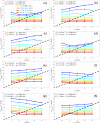Statistics of maximum photon penetration depth in a two-layer diffusive medium
- PMID: 38404319
- PMCID: PMC10890894
- DOI: 10.1364/BOE.507294
Statistics of maximum photon penetration depth in a two-layer diffusive medium
Abstract
We present numerical results for the probability density function f(z) and for the mean value of photon maximum penetration depth ‹zmax› in a two-layer diffusive medium. Both time domain and continuous wave regime are considered with several combinations of the optical properties (absorption coefficient, reduced scattering coefficient) of the two layers, and with different geometrical configurations (source detector distance, thickness of the upper layer). Practical considerations on the design of time domain and continuous wave systems are derived. The methods and the results are of interest for many research fields such as biomedical optics and advanced microscopy.
© 2024 Optica Publishing Group.
Conflict of interest statement
A.P. and A.T. are co-founders of PIONIRS Srl, spin-off company of the Politecnico di Milano.
Figures














References
-
- Schimleck L., Ma T., Inagaki T., et al. , “Review of near infrared hyperspectral imaging applications related to wood and wood products,” Appl. Spectrosc. Rev. 58(9), 585–609 (2023).10.1080/05704928.2022.2098759 - DOI
LinkOut - more resources
Full Text Sources
